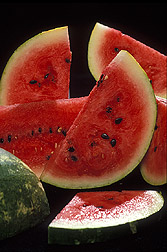This page has been archived and is being provided for reference purposes only. The page is no longer being updated, and therefore, links on the page may be invalid.
Of Watermelon and Waistlines: New Low-Sugar Varieties from ARS
By Erin PeabodyJuly 19, 2007
Just in time for bathing suit season: a leaner, meaner watermelon that boasts all the refreshing flavor and good-for-you nutrients of many conventional varieties, but contains more than 50 percent less sugar.
Agricultural Research Service (ARS) plant geneticist Angela Davis in Lane, Okla., is the chief breeder of two new low-sugar melons that should be a welcome treat for dieters, diabetics and everyone else wishing to curb their sugar or carb intakes.
Davis, who works at the ARS South Central Agricultural Research Laboratory in Lane, is currently sharing the new watermelon stock with interested growers. And while their official debut will depend upon farmers' receptiveness, the seeded watermelons could start showing up in produce aisles by summer's end.
Davis embarked on the quest for a naturally low-sugar watermelon after realizing the popular fruit was off limits for many consumers, including the nation's more than 20 million diabetics.
But don't blame the melon for its current sugary taste. Over the decades, breeders have increasingly selected for sweeter and sweeter fruit. In fact, heirloom watermelons that might have rolled out of Granddad's garden contained about 25 percent less sugar than their contemporary cousins.
Davis wasn't sure if she'd be able to achieve a low-sugar, red-fleshed melon, given the tendency of richly-pigmented watermelons to contain higher levels of sugar. But after screening hundreds of watermelons, she discovered one with golden flesh and low sugar. It provides the genetic foundation for the current lines, which are red.
Like all watermelons, the new cultivars are an excellent source of lycopene, a powerful antioxidant associated with a lower incidence of some cancers. They're also rich in vitamin A and potassium.
And for those who might miss the sweetness of this summertime favorite but don't want to sacrifice calories, a little artificial sweetener can be sprinkled onto the fruit to give it a flavor that's comparable to conventional watermelons.
Davis has also developed a melon that's middle-of-the-road in terms of its sugar content, satisfying consumers who still desire a touch of natural sweetness.
ARS is the U.S. Department of Agriculture's chief scientific research agency.

